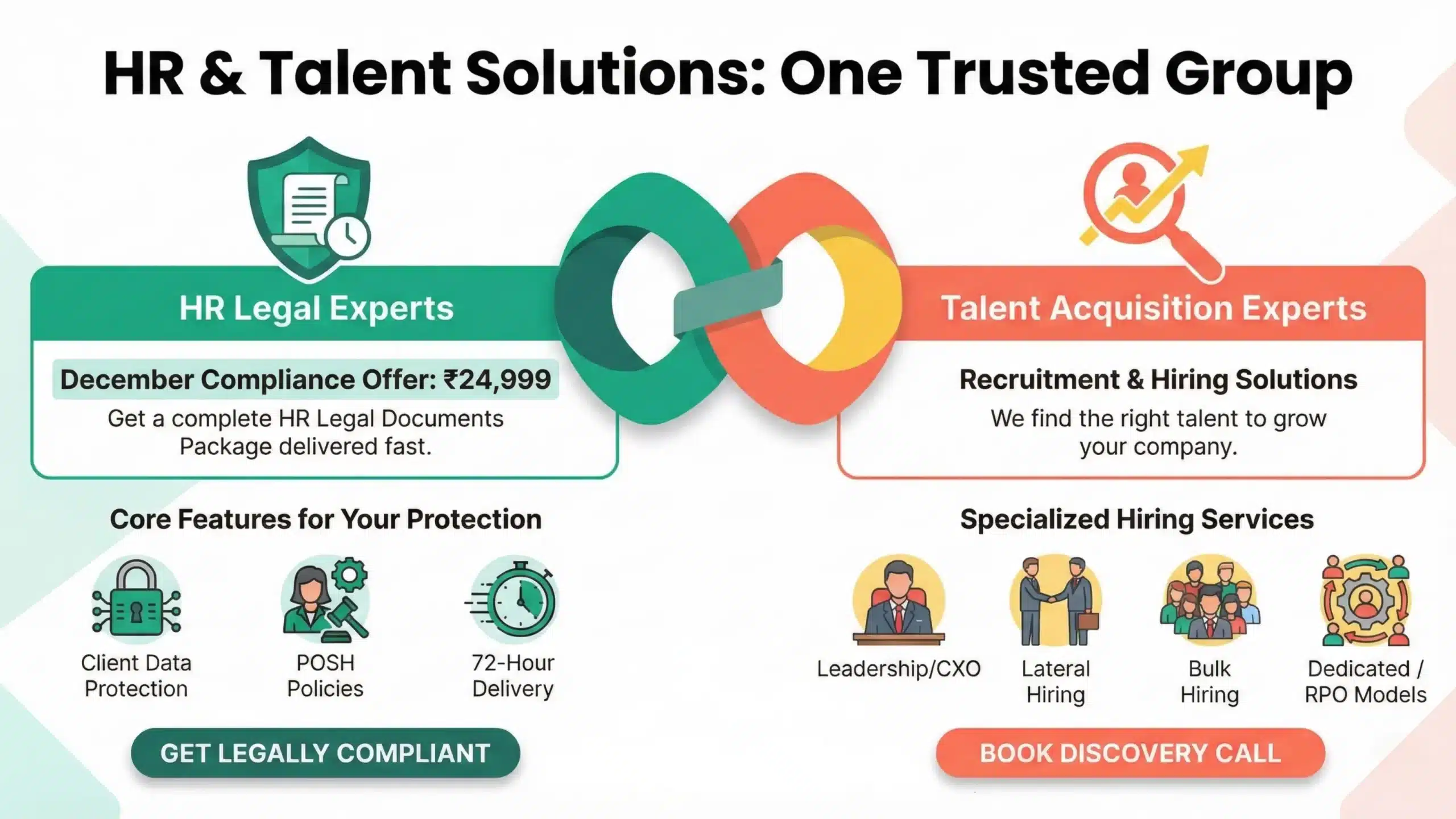Let’s be honest—HR legal policies sound boring…
Until something blows up.
A dispute.
A messy resignation.
An ex-employee walks off with your client database.
That’s when everyone scrambles to find the “policy.”
But what if those policies actually made sense from the beginning?
What if they were clear, human, and written to prevent this mess in the first place?
That’s what real HR legal support is all about.
And this guide?
It’s for founders, HR heads, and startup teams that are juggling 10 things at once, but know that people problems can quickly become legal problems.
Let’s get you out of reactive mode and guide you to prevention mode.
Table of Contents
ToggleWhy HR Legal Policies Matter More Than You Think
Every workplace has people.
And where there are people, there are grey areas.
“What if someone shares confidential data on their way out?”
“What if a harassment complaint is mishandled?”
“What if someone expects a bonus that was never formally agreed on?”
These aren’t “soft” issues.
They’re legal risks.
And many MSMEs—especially the fast-growing ones—realise this too late. Not because they don’t care, but because they’re focused on growth and survival. That’s fair.
But here’s the thing:
A legally sound HR foundation doesn’t slow you down.
It keeps you standing.
Where Things Usually Go Wrong (and Cost You)
Most companies we meet think their legal policies are in place
But when we dig in, it’s a mix of outdated templates, patchy compliance, and “we’ll fix it when something happens.”
Here are a few real risks that show up:
1. No Clarity on Data & Info Theft
When someone exits, what stops them from taking client lists or IP with them? If your contracts and policies aren’t sharp, you’re exposed.
2. Vague Leave Policies
Who’s eligible for what leave? How much? And when? If the answer is unclear, expect confusion, frustration, and eventually conflict.
3. Dress Code & Workplace Conduct Gaps
It sounds trivial until someone shows up inappropriately dressed to a client meeting or violates workplace conduct with no clear consequence.
4. Overtime & Work Hour Disputes
If you don’t spell out working hours, compensatory offs, and overtime structure, expect friction—and sometimes, labour law trouble.
5. Onboarding That Misses the Legal Basics
Skipping NDAs, IP clauses, or clear role definitions during onboarding is a long-term risk. Those first-day documents matter.
6. Payment, Gratuity & Incentive Confusion
People want clarity on how they’re paid, what bonuses apply, and how gratuity works. Ambiguity breeds dissatisfaction—and lawsuits.
7. Bribery, Vendor Misconduct & Reputation Risk
No anti-bribery policy? No vendor code of conduct? You’re at risk of being dragged into unethical or even illegal activity without knowing it.
8. Grievance Redressal that Goes Nowhere
People need to know how to raise concerns confidentially, safely, and with a promise of resolution. Otherwise, issues rot under the surface until they explode.
9. Exit Chaos
A mismanaged exit can lead to claims of wrongful termination, missed settlements, or even legal proceedings. A checklist helps, and a strong policy saves you.
10. Weak Employment Agreements
If your employment agreements don’t hold up in court—or aren’t updated with current legal requirements—you’ve already lost the battle.
What a Strong HR Policy Framework Looks Like
You don’t need a 200-page legal document.
You need a living, breathing guide that your team actually reads and follows.
Let’s break down what that looks like in practice:
1. Onboarding & Employment Agreements
- Clear job roles and responsibilities
- Confidentiality and non-disclosure clauses
- IP ownership terms, especially for creative or tech teams
- Non-compete or non-solicit clauses (where legally valid)
You’re not just offering a job—you’re defining expectations on Day 1.
2. Leave, Working Hours & Attendance
- Clarity on working hours, breaks, and overtime
- Types of leave (earned, sick, casual, maternity/paternity)
- Approval workflows and what’s considered paid/unpaid
This reduces confusion, sets boundaries, and protects both sides.
3. Pay, Gratuity & Incentives
- Salary structure and how bonuses are earned
- Gratuity terms and statutory dues
- Incentive criteria tied to transparent metrics
When it comes to money, nothing should be vague. Clear policies = fewer disputes.
4. Dress Code & Professional Conduct
- What “appropriate” looks like in your culture
- Rules on safety gear (if applicable)
- Conduct expectations, inside and outside the workplace
- Anti-bribery and anti-fraud rules
This isn’t about being strict. It’s about alignment and protection.
5. Communication & Grievance Redressal
- Safe channels for employees to report issues
- Defined process for internal investigations
- Protection for whistleblowers
Most companies delay this until they need it. That’s the worst time.
6. Termination & Exit Protocol
- Notice periods, handover, and final settlements
- Return of company assets
- Access revocation and data handling steps
Smooth exits protect both reputation and IP. You need this.
Real-Life Scenarios (You’ll Probably Recognise One)
Let’s take it out of theory for a second:
Scenario 1: The Exit That Got Messy
An employee resigns. No checklist. No proper handover. Laptops and data disappear.
Fix: A clear exit process in the handbook with asset return, access deactivation, and NDA reminders.
Scenario 2: The Bribe No One Saw Coming
A manager gifts a client vendor something “small.” It snowballs into a compliance nightmare.
Fix: Add anti-bribery policies to your code of conduct. Educate managers during onboarding.
Scenario 3: Burnout Over Sick Leave
Team members push through illness because they “weren’t sure how to apply for leave.”
Fix: Define leave types, eligibility, and approval steps. Normalise taking time off when unwell.
Making HR Policies Actually Readable (and Followable)
You can draft the world’s best policy, but if no one reads or understands it, it won’t protect you.
Here’s how to fix that:
- Use plain English: Avoid jargon. If you must use a legal term, explain it like you’re talking to a new team member.
- Structure clearly: Break long blocks into sections with headings and bullets.
- Add real-world examples: Bring policies to life with context.
- Keep it short—but not shallow: Be thorough but not exhausting.
- Review and update annually: Compliance changes. So should your handbook.
Why Startups & MSMEs Need Legal Policies Even More
If you’re an early-stage company or a growing MSME, HR legal policies aren’t just paperwork.
They’re your culture on paper.
They decide how your team behaves, how decisions get made, and how problems get solved.
And in smaller companies, one bad hire or one unclear policy can create ripple effects you don’t recover from quickly.
Big companies have the luxury of in-house legal teams and HR departments to fix gaps. You don’t.
You need someone who understands the pace and pressure of growing a business, who can draft policies that actually scale.
That’s where the right HR legal partner makes a difference.
Someone who understands the law but speaks business.
Who can build your policies in plain English, so your team doesn’t just receive them?
They get them.
That’s what we do. Quietly. Clearly. Without drama or jargon.
The Long-Term Wins of Getting HR Policies Right
When you treat policies as more than a checklist, here’s what happens:
- Conflicts drop—because expectations are clear
- Onboarding becomes smoother—because roles and responsibilities are already spelled out
- Trust builds—because employees know what’s fair and what’s not
- Attrition goes down—because people feel safe and supported
- Legal risks shrink—because your business is already protected
And most importantly?
You get more energy for growth.
Less energy wasted on damage control.
Final Word: Make Policies Human And Legal
‘HR Legal Policies’ aren’t about control. They’re about clarity.
They’re how you protect your people and your company.
Legal compliance isn’t the end goal. It’s the baseline.
What matters more is building a culture that works—one in which expectations are clear, fairness is written down, and people feel safe to show up and do good work.
That’s the real job of HR legal services.
If you’re trying to figure out how to handle terminations, resolve disputes, or avoid compliance gaps before they cost you—
This guide might be exactly what you need:
👉 Top 10 HR Legal Services FAQs Businesses Need Answered Now
And if you need expert guidance, HR Legal Experts (a branch of Corporate Stalwarts) is here to help – cut the paperwork chaos and protect your business with ease.

Corporate Stalwarts is a trusted recruitment firm with 20+ years of expertise in executive search and leadership hiring.
We’ve placed 10,000+ candidates across 600+ companies in FMCG, Manufacturing, IT, Pharma, and more. Our 1M+ candidate pool and 48-hour turnaround enable fast, high-quality hiring solutions.
We help businesses build high-performance teams with precision, speed, and industry expertise.






